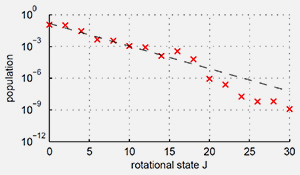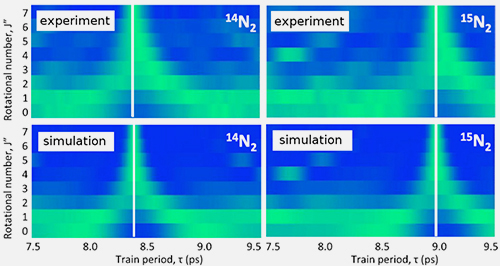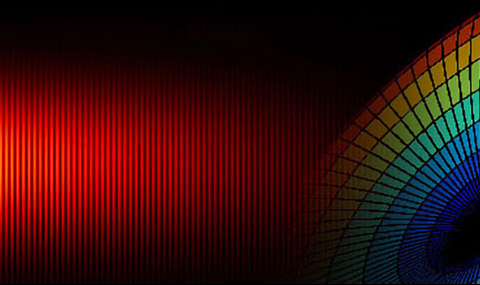The periodically kicked rotor is a textbook example of deterministic chaos: although an extremely simple system, the dynamics of a periodically kicked classical rotor can easily become chaotic. It was natural to use this model system in search of signs of chaos in quantized systems. However, the discrete levels of a quantum rotor prevent chaotic dynamics. Instead, the periodically kicked quantum rotor exhibits new phenomena, like quantum resonance or dynamical localization. We investigate one of the simplest natural systems for a kicked rotor: a linear molecule interacting with a periodic train of short laser pulses.

The effect of quantum resonance occurs when the molecules are kicked with a period that equals the rotational period of the molecule, which is a few picoseconds for small diatomic molecules like nitrogen. Under this condition, the absorption of energy is strongly enhanced. In a rigid rotor, the resonance causes an unlimited ballistic growth of the angular momentum. We show that the centrifugal distortion of rotating molecules eventually halts the growth, by causing Anderson localization beyond a critical value of the angular momentum—the Anderson wall. Below the wall, rotational excitation oscillates with the number of pulses due to a mechanism similar to Bloch oscillations in crystalline solids. Bloch oscillations in a gas of nitrogen molecules kicked by a periodic train of femtosecond laser pulses have been observed [8]. These oscillations are measured via the temporal modulation of the refractive index of the gas. Our results introduce room-temperature laser-kicked molecules as a new laboratory for studies of localization phenomena in quantum transport.
Equally interesting is the kicking with a period far detuned from the rotational period. Under this condition, the molecules become transparent to the laser kicks: no matter how much one kicks the molecules, they will not absorb any energy. Instead, the population distribution of the angular momentum states become exponentially localized, as shown in the picture. This effect is also due to a mechanism closely related to Anderson localization.

Under the condition of fractional quantum resonance, there are states of the kicked rotor that are strongly localized near the edge of the angular momentum space (near zero angular momentum). These states are analogs of surface states in crystalline solids, and they significantly affect resonant excitation of molecular rotation by laser pulse trains.
Interesting new opportunities arise when one considers both regimes – quantum resonance and dynamical localization – at the same time. For example, consider two molecules with different moments of inertia and therefore different rotational periods, like 14N2 and 15N2. Due to the different time scales, it is possible to devise a pulse train that strongly excites one molecular species under the condition of quantum resonance but leaves the other species unchanged under the condition of Anderson-like localization. Thereby, one can selectively excite rotations in just one molecular species in a mixture. As seen in the picture, when kicking with a period of 8.4 ps, only for 14N2 higher rotational levels are excited, and vice versa for a period of 9.0 ps, only for 15N2 higher rotational levels are excited. The experiments [2] were done by the group of Valery Milner from UBC, Canada.

- J. Floß and I. Sh. Averbukh, “Quantum resonance, Anderson localization, and selective manipulations in molecular mixtures by ultrashort laser pulses”, Phys. Rev. A 86, 021401(R) (2012)
- S. Zhdanovich, C. Bloomquist, J. Floß, I. Sh. Averbukh, J. W. Hepburn, and V. Milner,
“Quantum Resonances in Selective Rotational Excitation of Molecules with a Sequence of Ultrashort Laser Pulses”, Phys. Rev. Lett. 109, 043003 (2012) - J. Floß and I. Sh. Averbukh, “Quantum resonance, Anderson localization, and selective manipulations in molecular mixtures by ultrashort laser pulses”, Phys. Rev. A 86, 021401(R) (2012)
- J. Floß, S. Fishman, and I. Sh. Averbukh, “Anderson localization in laser-kicked molecules”,
Phys. Rev. A 88, 023426 (2013) - J. Floß and I. Sh. Averbukh, “Anderson Wall and Bloch Oscillations in Molecular Rotation”,
Phys. Rev. Lett. 113, 043002 (2014) - J. Floß, A. Kamalov, I. Sh. Averbukh, and P. H. Bucksbaum, “Observation of Bloch Oscillations in Molecular Rotation”, Phys. Rev. Lett. 115, 203002 (2015)
- J. Floß, and I. Sh. Averbukh, “Edge states of periodically kicked quantum rotors”,
Phys. Rev. E 91, 052911 (2015) - J. Floß, and I. Sh. Averbukh, “Exciting Molecules Close to the Rotational Quantum Resonance: Anderson Wall and Rotational Bloch Oscillations”, J. Phys. Chem. A, 120, 19, 3206 (2016)


